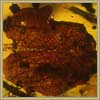

|
|
This is a petal from the flower of the now-extinct species of
algarrobo tree whose resin was the source of all Dominican
amber. Without this single species of tree, the fabulously
rich community of ancient life captured in Dominican
amber—which includes the largest fossil gathering of
land-dwelling invertebrates in a tropical
environment—would not have been preserved. This tan
petal probably fell shortly after the flower opened.
|
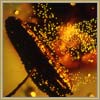

|
|
Amber can record the most fleeting moments of forest life.
Here, pollen grains that were in the process of spilling out
of a falling algarrobo stamen spread like a handful of tossed
salt onto the surface of the sticky resin. Millions of years
later, the grains remain intact, with their original
protoplasm still inside.
|
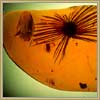

|
|
Resembling a floral sea urchin, this "spiked ribbon" seed has
long golden ribbons extending out from a coiled hub. The
ribbons were likely used to aid the seed's dispersal, but
precisely how is unknown. The source plant of the seed, whose
diameter is just over a half an inch from ribbon tip to ribbon
tip, has not been identified.
|


|
|
This fig wasp proves that plants of the fig genus existed in
the amber forest, even though no direct evidence of fig trees
or shrubs has turned up in Dominican amber. Each species of
fig today has its own specific wasp pollinator; experts
believe the same to have been true back then. Note also the
tiny wormlike creatures caught in the midst of escaping from
the wasp's body. Such nematodes today hitch a ride on fig
wasps to the next fig, where they multiply.
|
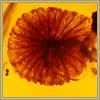

|
|
This extinct mushroom is the only known fossil tropical
mushroom ever found. One of the smallest members of the
so-called inky cap family, this specimen likely grew on the
bark of the algarrobo tree with others of its kind. When the
cinnamon-colored mushroom was overrun by a glob of resin, a
tiny mite grazing on its cap was entombed forever in the very
act of dining (see mite lower right).
|


|
|
Planthoppers were common in the amber forest. Like their
living relatives today, they used their needle-like beaks and
sucking mouthparts to draw out juices from within leaves. This
strikingly well-preserved planthopper was frozen in time so
quickly that it didn't even have time to retract its wings.
|
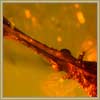

|
|
This "alligator-headed" planthopper indeed resembles its
reptilian namesake. And perhaps not just in name: scientists
have seen modern versions of such planthoppers resting with
their snouts high in the air, not unlike the stance that some
reptiles maintain. "Whether this behavior actually frightens
potential predators is unknown," writes George Poinar, Jr. in
his book The Amber Forest, "but why else would such a
posture evolve?"
|
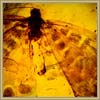

|
|
Very few adult butterflies have been found in Dominican amber,
and all those, including this one, belong to the metalmark
family. Small and speckled, this orange-brown butterfly may
have mistaken a patch of resin on an algarrobo tree for a
tasty pool of sap. The sticky resin would have instantly
immobilized its wings, which possessed nowhere near the
strength needed to lift away.
|
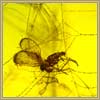

|
|
It was not a good day for this moth fly, which had the bad
luck to be caught twice, first in a spider web and then in
resin. These delicate strands of spider silk are so well
preserved that experts have been able to identify their
spinner: a member of the spider family Araneidae.
|
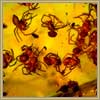

|
|
These recently hatched spiderlings might have been on the
verge of "ballooning" when they were trapped. Ballooning is a
technique young spiders use to travel long distances quickly.
Spiderlings climb to an exposed location and begin generating
silk threads. When the threads reach a certain length, the
wind lifts both them and the spiderlings aloft before dropping
them to the ground again some distance away. Experts have
collected some spiders thousands of feet in the air, showing
how successful this tactic can be.
|
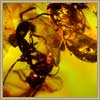

|
|
This army ant appears to have been out on a hunting mission
when it was entrapped. Judging from the wasp pupa beside it,
the worker had raided a wasp nest and was in the process of
carrying its prize back to the nest when it had the misfortune
of stepping or falling into a blob of resin.
|


|
|
Ant bugs like this one lie in wait on tree bark near foraging
ants. When hungry, they rear up and expose their undersides,
which release a secretion attractive to ants. As the ants
start feeding on the substance, they become lethargic from a
narcotic in the secretion. That's when the ant bug strikes,
savagely driving its beak into the weakened ant's body and
sucking out its life juices. The ant bug's hairs protect it
from any death-throe bites or scrabbles by its victim. Today,
ant bugs are extinct in the Western Hemisphere.
|
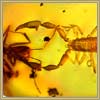

|
|
Other ant predators found on the algarrobo tree millions of
years ago were pseudoscorpions. When it succumbed to the
resin, this pseudoscorpion was in the midst of attacking an
ant. Victory for the assailant was not a foregone conclusion,
however; ants sometimes win such battles and destroy their
attackers.
|
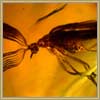

|
|
Parasitic beetles are uncommon today, but their natural
history tells us how beetles like this one with its bizarre,
antler-like lobes thrived in the amber forest. Though social
wasps are one of its prey, such beetles do not have to
encounter a wasp in order to parasitize it. Instead, the
beetle lays its eggs on or near flowers. When its larvae
hatch, they wait for a wasp to alight on the flower to imbibe
nectar. The larvae then grab hold of the wasp and hitch a ride
back to its nest, where they transform into grubs and dine on
wasp larvae. Later the grubs pupate in the soil and then go on
to continue the cycle.
|
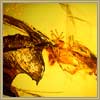

|
|
Lizards in amber are extremely rare—so rare that a
single intact specimen can bring hundreds of thousands of
dollars on the collectors' market. This gecko may have been
eyeing a tasty insect feeding on the leaf seen here when it
attacked the bug and unintentionally brought down the leaf and
itself into a mass of resin. The victim might still remain
inside the gecko's throat.
|
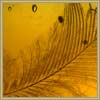

|
|
No entire birds have ever been found in amber, but parts of
them have, including this feather. While a variety of feathers
are known from amber, this is the only one that experts have
identified. It belonged to a small bird in the woodpecker
family known as a piculet. A relative of this bird called the
Antillean piculet still lives in the Dominican Republic today.
|


|
|
As with birds, no intact mammals have turned up in amber, but
traces of them have. Experts were able to guess what creature
left behind this tuft of hair both by examining microscopic
features in the strands and by identifying two
parasites—a fur mite and a fur beetle—found in the
hairs. These clues led them to conclude that this tuft
belonged to a rodent, possibly an extinct relative of the
hutia. Hutias are small, secretive creatures still living in
the Caribbean area today, millions of years after the owner of
this fur perhaps brushed up against an algarrobo, entombing a
swatch of its hair for eternity.
|

